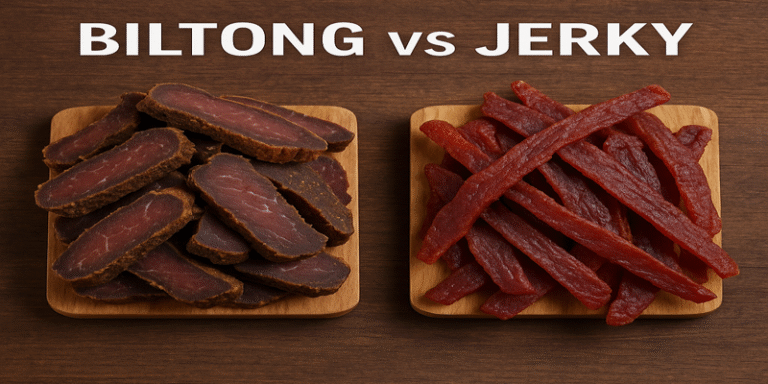Dried meat products such as biltong and jerky have gained global popularity due to their long shelf life, nutritional content, and convenience. Despite being superficially similar, these two snacks differ significantly in terms of origin, preparation, nutritional content, and food safety. This article critically compares biltong and jerky, drawing from academic studies, books, and credible online sources.
1.0 Historical Context
1.1 Biltong
Biltong originates in Southern Africa, especially South Africa, where it has been consumed since the 17th century. Dutch settlers preserved meat by curing it with salt, vinegar, and spices before air drying, which became the traditional method of making biltong (Wikipedia, 2024; Ember Snacks, 2023). Biltong’s flavour profile is influenced by the use of vinegar and coriander, introduced by European settlers (Wikipedia, 2024).
1.2 Jerky
Jerky has its roots in South America. The word derives from the Quechua term ch’arki, meaning “dried, salted meat” (Wikipedia, 2024). It was later adopted by North American settlers and commercialised in the United States. Modern jerky is commonly produced using lean meats sliced thin and dried using heat or smoke (Hasheider, 2015).
2.0 Processing Methods
Although both snacks involve meat preservation through drying, the processes differ markedly. Biltong is made by marinating thick cuts of meat in vinegar, salt, and spices, then air-drying it over several days to weeks (USDA, 2020). In contrast, jerky is produced by slicing meat thin, marinating it in sweet or savoury sauces, and then drying it using heat (Hasheider, 2015).
Unlike jerky, biltong typically does not undergo any heat treatment, relying instead on acidity, salt concentration, and reduced water activity to ensure shelf stability (USDA, 2020; Claasens, 2023).
3.0 Food Safety
Due to the absence of heat treatment, biltong’s safety depends on strict control of microbial activity through marination and drying parameters (USDA, 2020). The USDA recommends that manufacturers validate a 5-log reduction in pathogens such as Salmonella to meet safety standards.
Jerky production, on the other hand, involves thermal processing (≥71°C), which effectively kills pathogens during dehydration (Zhou et al., 2022). This makes jerky more acceptable in highly regulated markets like the United States.
4.0 Nutritional Profile
Nutritionally, both snacks are rich in protein and low in carbohydrates, making them popular with athletes and dieters. However, biltong is often considered healthier due to the absence of added sugars and preservatives (Healthline, 2023). It also retains more vitamins, especially B12, due to its non-thermal processing (Chief Nutrition, 2024).
Jerky often contains added sugar, soy sauce, and preservatives like sodium nitrite, which can contribute to higher sodium intake (Wikipedia, 2024). A standard serving of jerky may contain over 600 mg of sodium, compared to the relatively lower sodium content in traditional biltong (Ember Snacks, 2023).
5.0 Sensory Differences
Biltong typically has a softer, chewier texture and a tangy, spice-forward flavour due to the presence of vinegar and coriander. It is usually thicker than jerky and may include fatty cuts for added richness (Claasens, 2023).
Jerky, on the other hand, is thinner, drier, and more leathery. It often has a smoky or sweet flavour due to the use of liquid smoke and sugar in the marinade (Hasheider, 2015). These differences cater to different palates and consumption cultures.
6.0 Cultural Significance and Market Trends
Biltong is deeply ingrained in South African culture, where it is widely consumed as a snack or even a weaning food for infants (Reddit, 2023). In recent years, it has gained international popularity, especially in the UK and Australia.
Jerky dominates the North American market and is a staple in camping, hiking, and sports nutrition segments. The global jerky market is projected to reach USD 8.8 billion by 2033, reflecting its massive commercial appeal (Wikipedia, 2024).
7.0 Environmental Considerations
Some biltong producers are adopting sustainable practices by sourcing from regenerative farms and avoiding artificial additives (Chief Nutrition, 2024). Jerky manufacturers, particularly large-scale ones, tend to rely on industrial meat sources, which may have a higher environmental impact due to packaging, energy use, and preservatives.
8.0 Summary
Though both are meat-based snacks, biltong and jerky differ in:
- Origin: Southern Africa vs South/North America
- Processing: Air-dried with vinegar (biltong) vs heat-dried with sauces (jerky)
- Texture: Thicker and tender (biltong) vs thin and chewy (jerky)
- Nutrition: Lower sugar and higher vitamin retention in biltong
- Safety: Jerky includes a heat step; biltong requires process validation
- Cultural Role: Biltong is a traditional staple in South Africa; jerky is a mass-market snack in the US
Ultimately, the choice between biltong and jerky depends on personal preference, health considerations, and cultural affinity.
References
Chief Nutrition (2024) Biltong vs Jerky: What’s the Difference?, Chief Nutrition. Available at: https://wearechief.com/en-us/blogs/articles/whats-the-difference-between-jerky-and-biltong (Accessed: 20 July 2025).
Claasens (2023) Beef Biltong vs Jerky: The Key Differences, Claasens. Available at: https://www.claasens.com/post/beef-biltong-vs-jerky (Accessed: 20 July 2025).
Ember Snacks (2023) So What Is Biltong?, Ember Snacks. Available at: https://embersnacks.com/blogs/news/so-what-is-biltong (Accessed: 20 July 2025).
Hasheider, P. (2015) The Complete Book of Jerky: How to Process, Prepare, and Dry Beef, Venison, Turkey, Fish, and More. Minneapolis: Voyageur Press.
Healthline (2023) Biltong: Is It Healthy?, Healthline. Available at: https://www.healthline.com/nutrition/biltong (Accessed: 20 July 2025).
Reddit (2023) What is Biltong?, Reddit. Available at: https://www.reddit.com/r/Biltong/comments/du7n2s/what_is_biltong/ (Accessed: 20 July 2025).
USDA (2020) ‘Processing of Biltong (Dried Beef) to Achieve USDA-FSIS 5-log Reduction of Salmonella’, USDA Food Safety and Inspection Service. Available at: https://www.ncbi.nlm.nih.gov/pmc/articles/PMC7285303/ (Accessed: 20 July 2025).
Wikipedia (2024) Biltong. Available at: https://en.wikipedia.org/wiki/Biltong (Accessed: 20 July 2025).
Wikipedia (2024) Jerky. Available at: https://en.wikipedia.org/wiki/Jerky (Accessed: 20 July 2025).
Zhou, L., et al. (2022) ‘Drying Processes and Safety of Meat Snacks: A Review’, Microorganisms, 10(7), pp. 1308–1315. doi:10.3390/microorganisms10071308.









